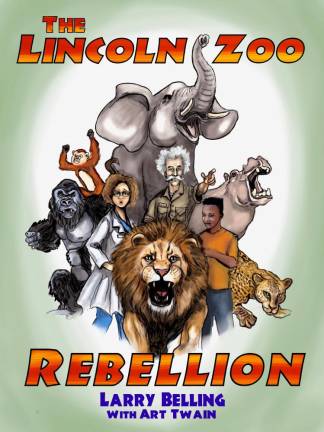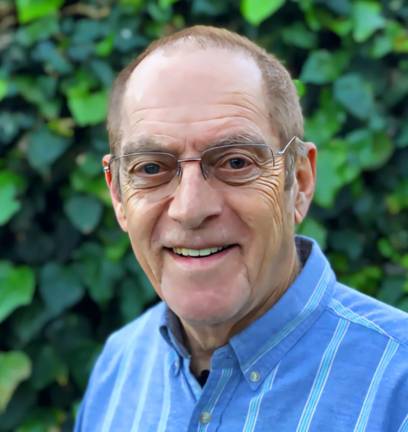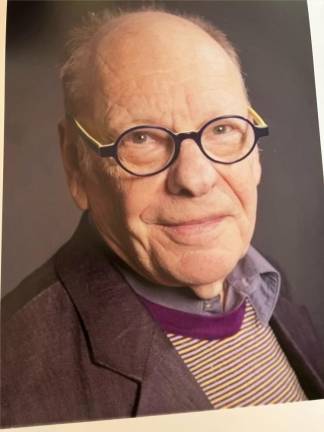He Turns His Innate Appreciation for Animals into a Children’s Book
Former ad exec Art Twain talks about his inherent love for animals, his accomplished advertising career and his new children’s book which he completed after Larry Belling, his lifelong friend and co-author, died.



As a teen in Oakland, California, Art Twain had over 25 animals in his garage zoo, and always stopped to save creatures that were in danger. “My mother said I was studying to be an animal,” he said. “And I trusted them. To me, they were nicer than people.”
Although he first dreamed of becoming a veterinarian, Twain became an Emmy-winning advertising executive, producing over 3,000 radio and TV spots, and working with brands like Levi’s and the Gap.
He recently co-authored “The Lincoln Zoo Rebellion,” with his childhood friend Larry Belling, who passed away as they were still working on the project. Belling’s wife, Davina, a film and television producer, assisted with the completion of the book, which was published on February 29.
Meant for children ages 8 to 14, it tells the tale of a zookeeper, veterinarian, animals and kids who band together to defend the zoo, which is in danger of being turned into an amusement park.
When asked what he hopes readers will take away from the book, he said, “An appreciation for what zoos do for animals, that animals have rights, and they’re just not creatures to be kept in little cages.”
Tell us about all the pets you had in your garage when you were a kid and the animals you’ve saved.
I had different species of rats and mice, snakes, lizards. I had two alligators, a two-and-a-half foot one and an eight-inch one. One day I found a little tiny pink thing in the driveway and it was a little baby opossum that had fallen out of its mother’s pouch; it was premature. So I thought, “I’ll do my best to see what I can do to keep it alive,” and sure enough, I kept him alive until he was an adult. Oh my gosh, I’ve saved a lot of animals, a Swainson’s hawk with a broken wing, various birds, a cecropin moth, three baby skunks.
So your parents were OK with all of that?
My parents were more than remarkable. I chose the right parents. [Laughs]
Where do you think this passion for animals came from? Were your parents animal lovers?
My parents were just loving, great people. I have three brothers and whatever each of us took on as being our favorite thing, it became their favorite thing too. So we had nothing but encouragement.
I read that you originally wanted to become a veterinarian.
Two years of pre-veterinary medicine and then I decided that wasn’t going to work for me, so I changed majors to communications and public policy, which was the creative door to advertising.
Tell us about your career in advertising.
Well I was very fortunate, I was hired at an ad agency. For every job that was open in San Francisco, there were 400 people waiting for it, most of them way more ready for it than I was. But the creative director saw me as an alter ego. I was sort of the same age, married, with a child and played musical instruments and he thought that was cool, so he hired me. And after a year of working at the ad agency, I wrote an ad that won The Best Ad in San Francisco. It was for Shipstads & Johnson Ice Follies and it was written on lined paper and it looked like a child had drawn all the pictures. It said, “I saw a teddy bear on ice.” It was sort of a review of the ice follies given by a third-grader. So that went well.
Then I worked for three different ad agencies, at the last one, being the head writer on the Levi’s account to bring them into radio. And I wrote an ad for them that won all sorts of awards and sold out every pair of Levi’s in New York City in a weekend. And I ended up winning Clios [awards that recognize innovation and creative excellence in advertising, design and communication], and an Emmy and things like that. I never put up anything for an award, my clients did.
What about your work with the Gap?
When I was the head writer on the Levi’s account, a real estate guy, Don Fisher came to the ad agency and wanted to know if they could handle his account. He was going to open his first retail store. He never had one before. And they told him that they couldn’t handle him, he was too small, but maybe one of the writers would do it as an outside job, and that was me. The store was going to be named Pants and Discs because they were going to sell the two things teenagers wanted most, Levi’s and records. He thought that people would come in for the records and incidentally buy some Levi’s and he would carry every one of the 32 models of Levi’s that they made. Because most of the stores, the most they ever carried was four models and they carried only even sizes. So he wanted to have everything, all sizes, all models.
The name was going to be Pants and Discs and we changed it to the Gap. Don was with his wife Doris at a cocktail party in La Jolla, California. They’re coming out from the party there and Doris says, “The Gap!” Don said, “What’s the gap?” “That’s the name for the store. The Gap.” Don said. “Oh, you mean like generation gap?” “No, just the Gap,” Doris said.
She had no big reason for it. A few minutes later Don phoned me at my home and told me the name. Don and I were in touch by phone because we had to come up with the name of the store by the next morning. The painters were coming to paint a name on the store. We were both supposed to give our favorite names. Mine was Cricket and his was Gap and I said, “Nah, too country and western.” He said, “Let’s think about it,” and we got back together and I thought, “You know, that is a good idea because it’s both solid as an entity, but it’s also a space that needs to be filled.” And the rest is history. [Laughs]
Is “The Lincoln Zoo Rebellion” your first book?
No, I wrote the biography of Don Fisher, founder of the Gap stores. It was called “Falling into the Gap,” and at the last moment, his wife wanted privacy and decided to take the book off the shelf. We were told that the advance on the book would be $3.2 million dollars because at the time, biographies were really big. So I cried in my beer, if I ever drank beer. Then, I co-authored a book with my brother called “The Precious Few,” which came out a year ago. I guess this is book number three. I’ve got a few more to write.
You co-authored it with your lifelong friend, Larry Belling. When did you work on the book?
Larry had worked on it for quite a few years, started putting the book together. I introduced him to my agent. But the book wasn’t really ready for publishing and I said it needed some things and so we worked together on that. And I started editing and rewriting and so on and so forth and we ended up with a book.
How was Larry’s wife, Davina, involved?
Davina was with Larry every step of the way as he and I wrote the book. She’s terrific. She’s a movie producer from the UK and has won a lot of awards. Larry had an operation, it’s almost two and a half years ago now, and he said he felt just fine and he died two days later.
What can you tell us about zoos today?
Zoos today get their animals usually from either breeding programs in the zoos or rehabilitation facilities that are around the world that are taking orphaned animals that poachers have maybe killed the parents, or animals that are sick or injured but can’t be put back into the wild. Zoos are getting better about creating nice habitats for the animals. Habitats all around the world are diminishing. Poachers are a problem; they’re killing animals for food and for profit. There are more and more game preserves and rehabilitation facilities that are coming up to try to save animals from becoming extinct.